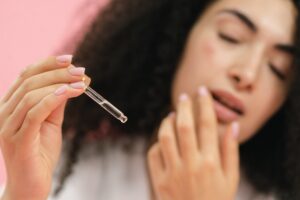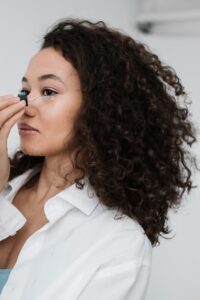Plump and Hydrated Skin

Hyaluronic acid is a well-known ingredient in the skincare industry, revered for its hydrating and plumping effects on the skin. As we age, our skin loses its ability to retain moisture, leading to dryness, wrinkles, and fine lines. Hyaluronic acid helps to counteract this effect by drawing moisture into the skin, resulting in a more youthful and radiant complexion. While there are plenty of hyaluronic acid serums available on the market, making your own DIY serum can be a fun and cost-effective way to incorporate this powerhouse ingredient into your skincare routine.
To make a DIY hyaluronic acid serum, you will need just a few simple ingredients: distilled water, hyaluronic acid powder, and a preservative. It’s important to note that hyaluronic acid is most effective when used in a concentration of 1% or less, so you’ll want to use a kitchen scale to measure out the correct amount of powder based on the size of your batch. A small batch, using 1 gram of hyaluronic acid powder, will yield about 100 ml of serum.
To start, you’ll want to sterilize your equipment to ensure that your serum is free from any bacteria or contaminants. This can be done by boiling your glass jar, pipette, and measuring spoons in a pot of water for at least 10 minutes. Once your equipment has cooled, you can begin the process of mixing your serum.
Begin by adding 97 ml of distilled water to your glass jar. You can use a funnel to make this process easier and to avoid spilling any water. Next, using a pipette, add 1 gram of hyaluronic acid powder to the water, being sure to sprinkle it evenly across the surface of the water to avoid clumping. Allow the powder to sit for a few minutes to fully dissolve.
Once the hyaluronic acid powder has dissolved, you can add a preservative to your serum to ensure that it stays fresh and free from bacteria. There are a number of different preservatives that can be used in skincare formulations, such as Optiphen, Germall Plus, and Leucidal Liquid. Be sure to follow the manufacturer’s instructions for your chosen preservative, as different preservatives will have different usage rates.
Once you’ve added your preservative, you can stir your serum gently to ensure that all of the ingredients are well combined. You can then transfer your serum to a dropper bottle or pump bottle for easy application.

To use your DIY hyaluronic acid serum, simply apply a few drops to clean, damp skin before applying your moisturizer. Hyaluronic acid is most effective when used on damp skin, as it helps to lock in moisture and provide a more hydrating effect. You can also use your serum throughout the day to refresh and hydrate your skin.
While making your own skincare products can be a fun and rewarding experience, it’s important to keep in mind that not all ingredients are suitable for all skin types. If you have sensitive or reactive skin, it’s a good idea to do a patch test on a small area of your skin before using your serum all over your face. Additionally, if you experience any irritation or discomfort after using your serum, discontinue use and consult with a dermatologist.
In conclusion, making your own DIY hyaluronic acid serum can be a simple and effective way to incorporate this hydrating ingredient into your skincare routine. With just a few simple ingredients, you can create a product that will help to plump and hydrate your skin, resulting in a more youthful and radiant complexion. By taking the time to sterilize your equipment and follow proper formulation guidelines, you can ensure that your serum is safe and effective for use. Not only is making your own skincare products a fun and cost-effective way to indulge in self-care, but it also allows you to have control over what ingredients are going onto your skin. With a little bit of research and experimentation, you can create a personalized skincare routine that addresses your specific skin concerns.
Hyaluronic acid is a versatile ingredient that can benefit all skin types, from oily to dry. It’s important to note that while hyaluronic acid can help to hydrate and plump the skin, it won’t necessarily address other skin concerns such as fine lines, wrinkles, or hyperpigmentation. As such, it’s a good idea to incorporate other active ingredients into your skincare routine as well to address these concerns.

Overall, incorporating a DIY hyaluronic acid serum into your skincare routine can help to provide a boost of hydration and plumpness to your skin. By taking the time to make your own serum, you can have peace of mind knowing exactly what ingredients are going onto your skin and can tailor the formulation to your specific skin concerns. So why not give it a try and see the difference it can make for your skin?

